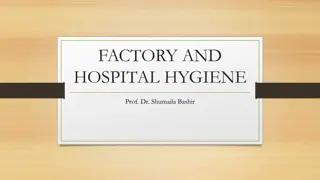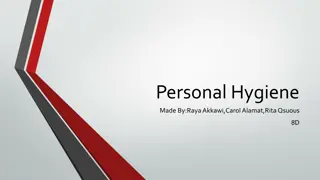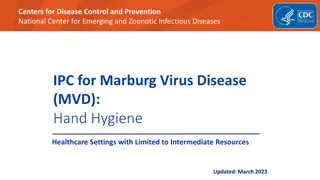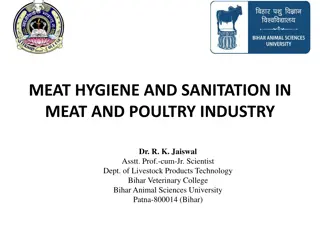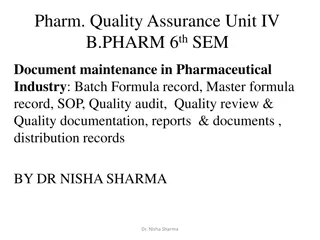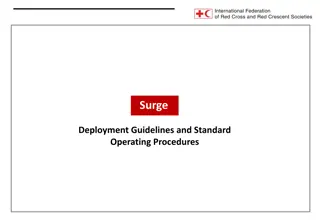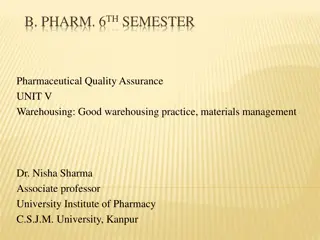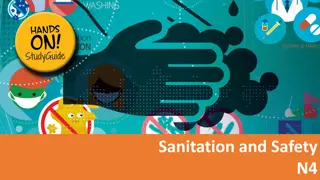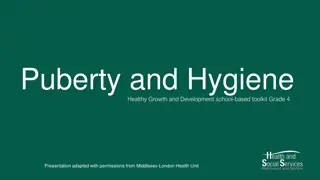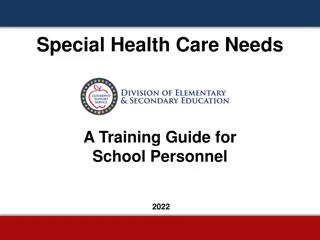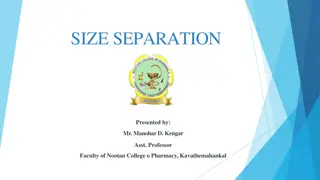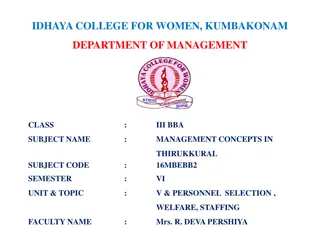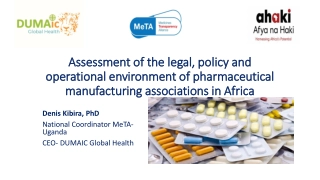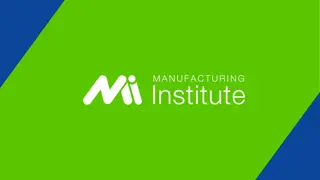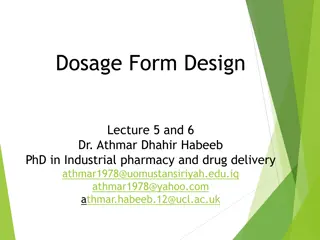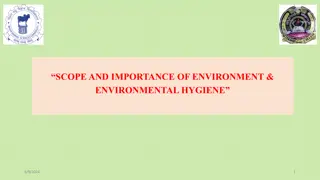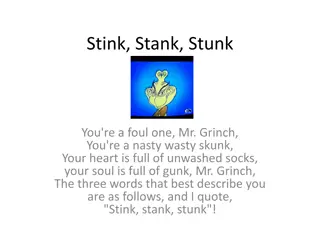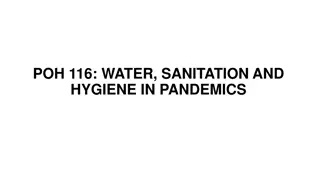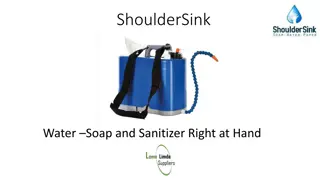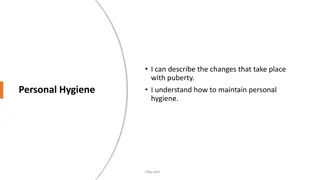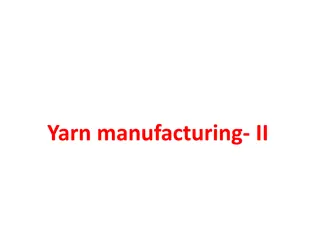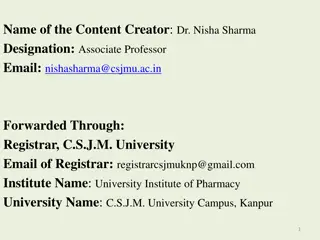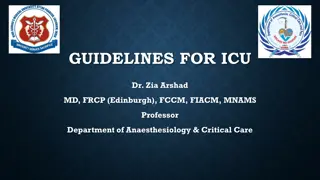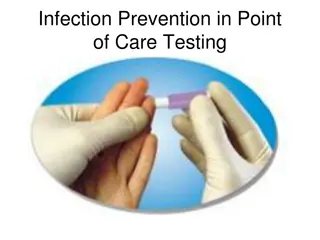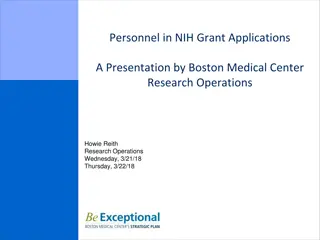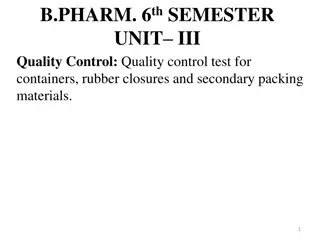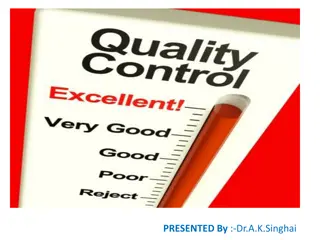Guidelines for Personnel Training and Hygiene in Pharmaceutical Manufacturing
Personnel responsibilities in a manufacturing unit include training, hygiene, and maintaining personal records. Guidelines as per Sch.M of D&C act 1945 outline the supervision, qualifications, and duties required for technical staff, QC lab, and QA personnel. Health, clothing, and sanitation protocols are detailed, emphasizing regular medical examinations, sensitivity testing, and safe handling practices. Direct contact between personnel and materials is to be avoided, with specific requirements for cleanliness, changing facilities, and prohibited activities in production and testing areas. WHO GMP guidelines outline the responsibilities of production and quality unit heads in ensuring compliance and adherence to GMP requirements.
Download Presentation

Please find below an Image/Link to download the presentation.
The content on the website is provided AS IS for your information and personal use only. It may not be sold, licensed, or shared on other websites without obtaining consent from the author. Download presentation by click this link. If you encounter any issues during the download, it is possible that the publisher has removed the file from their server.
E N D
Presentation Transcript
ORGANIZATION AND PERSONNEL Personnel responsibilities Training Hygiene Personal Records
Personnel To carry out various tasks in manufacturing unit- sufficient no. & qualified personel Individual responsibilities of persons concerned & to be recorded All must be aware of GMP Therefore, training, hygiene instructions required
Guidelines as per Sch M of D&C act 1945 Mfg. must be under supervision of technical staff with req. qualification & practical experience in relevant field Head, QC lab should b independent of Mfg. Dept. QA, QC personel- req. qualification & practical experience Written duties to be laid down & followed strictly Regular in service training programmes for personnel of production area as per duty assigned to b ensured by licensee
Health clothing & sanitation Handing of beta lactum antibiotics- persons to be tested for penicillin sensitivity before employment Handling of cytotoxic substances & potent drugs- regular examination for adverse effects Persons should be moved from these sections on rotational basis for health safe guard Before employment- medical examination including eye, communicable, contagious diseases testing Medical examination once a year, with proper record Training in practices of mfg. to ensure personnel hygiene Person with apparent illness must not b allowed to handle starting, packaging, in process materials & drug products which may have adverse affect on quality of products. Personnel must report about their illness to supervisor
Direct contact to b avoided between unprotected hands of personnel & raw materials, intermediate or finished products Must wear clean body coverings for their concerned duties. Before entering mfg. area, changing rooms for each gender with facilities of cleanliness like wash basin with running water, clean towels, hand dryers, soaps, disinfectants etc. Cabinets for storage of personnel belongings. Smoking, eating, drinking chewing not be permitted in production and testing areas.
WHO GMP guidelines for personnel involved in the mfg of Pharmaceutical products Head of production & quality unit have following responsibilities: Authorization of written procedures Monitoring of manufacturing environment Maintenance & evaluation of personnel hygiene Conduction of process validation & calibration of analytical instruments Organizing personnel training Evaluation of in process controls Documentation of records Checking status of compliance with GMP requirements Performing self inspection Approval or rejection of starting materials, packaging materials & finished products in relation to their specs. Evaluation of batch records Monitoring of analysis carried out under contract Checking of maintenance of premises & equipments Implementation and maintenance of quality system
Responsibility of Authorized personnel to release a batch To ensure that principles of GMP have been followed Mfg. and testing procedures have been validated All necessary test have been performed All required Production and QC documentation have been completed & certified by supervisors trained in appropriate disciplines Relevant audits & self inspections are carried out by experienced and trained staff
KEY PERSONNEL Includes Head of Production/Quality unit or authorized person Quality unit Head: To observe QA & QC functions Full time basis Should be independent heads Good Scientific education and Practical experience to perform independent professional judgement Education includes Chemistry or biochemistry Chemical engineering Microbiology Pharmaceutical sciences Pharmacology Toxicology
KEY PERSONNEL-Training Approved Training programmes as per written programme & relevant to allotted duties for all personnel must be conducted Written records of all trainings to be maintained Concept of hygiene, sanitation, quality audit etc to be discussed Must be trained on Theory & Practice of GMP Regular trainings with periodic assessments of practical effectiveness Special training for those working in hazardous area like clean areas, or areas with highly active or toxic or where infectious materials are handled Concept of QA & others that help to understand the implementation of GMP must be discussed during training Visitors/ untrained personnel must not be permitted into production or QC areas or else relevant information to be given in advance on personel hygiene and protective clothing.
Personal hygiene 1. Periodic health and eye examination for all 2. Instructions for hand wash before entering Mfg area 3. Person with open lesions/illness which might affect the quality of product should not be allowed to handle starting materials, in-process materials, or finished products until at risk 4. Automated/semi automated Mfg. process to be used to avoid direct contact of personnel with materials/bulk products 5. Should wear clean body coverings during duties in Mfg 6. Used cloths if reusable to stored separately & laundered, disinfected, sterilized 7. Smoking, eating, drinking, chewing or keeping food, drinking & smoking material not permitted in Production lab/store room etc. 8. Personnel hygiene procedures, wearing of protective clothing to be followed strictly in production areas
WHO GMP requirements for APIS PERSONNEL 1. Sufficient no./qualified personnel- education/ training/ experience to perform Mfg of API 2. Responsibilities of all the personnel must be recorded and documented 3. Training must be conducted regularly by qualified individuals & must cover the operations conducted by employees. Record of training 4. Periodic assessment of training
Personnel Hygiene 1. Good health habits to maintain personel hygiene and sanitation 2. Should wear clean clothing 3. Protective apparels like head, face, hand arm coverings to be worn when required to protect API s / intermediates from contamination 4. Avoid direct contact with intermediates or API s 5. Smoking, eating, drinking, chewing storage of food must be prohibited in designated areas 6. Personnel with infectious contagious disease or with open lesions on exposed surface should not be involved in activities so as to effect the quality of API s
CONSULTANTS To advise on Mfg. & control of intermediates of API s Must be qualified, trained, experienced Records to be maintained with names, address, qualification, types of services provided by consultants
WHO GMP guidelines for Mfg. of Sterile Products Personnel 1. Minimum no. in sterile areas particularly during aseptic processes. 2. Inspections, controls should be conducted outside such areas 3. Persons concerned with cleaning & maintenance in sterile areas to be given initial & regular training relevant to correct mfg. of sterile products, including hygiene & basics of microbiology 4. Staff engaged in processing of animal tissue material, cultures of microorganisms other than used in Mfg process should not enter in sterile product areas until rigorous and defined decontamination procedures have been followed
Personnel 5. Proper standards of personnel hygiene & cleanliness should be maintained by personnel involved in mfg of sterile product 6. Personnel working should be instructed to report any abnormal conditions that may be cause of contaminant 7. Periodic health checks for all personnel are desirable 8. Preventive & remedial actions must be taken by designated competent person with respect of personnel introducing undue microbial hazards in working area 9. Changing & washing should follow a written standard procedure designated to minimize contamination of clean area clothing or carry through contaminants to clean areas. 10. Clothing & its quality should be proper as per process & grade of working area 11. Clothing of personnel working in sterile area should be made of such fibres that no shedding from clothing is made 12. Clothing should be laundered or cleaned in such way that it does not gather additional particulate contaminants
Personnel 13. Clothing should be worn such that it protects the product from any contamination 14. Protective clothing like one piece jumpsuit, facemask etc & shoes/ shoe covers to be worn 15. Only disinfected gloves & masks should be used during working in the sterile area. Footwear should be disinfected or sterilized. Garment sleeves must be tucked into gloves 16. Personnel working in different grade areas should wear sanitized eye protector 17. Protective clothing must not shed any fibers/ particulate matter & must be able to retain particles shed by body. 18. Washing & sterilization process as SOP 19. Wearing of watches, jewellary or any kind of extreme fancy/cosmetic item by personnel should be prohibited 20. Hair, beard, moustache should be covered


